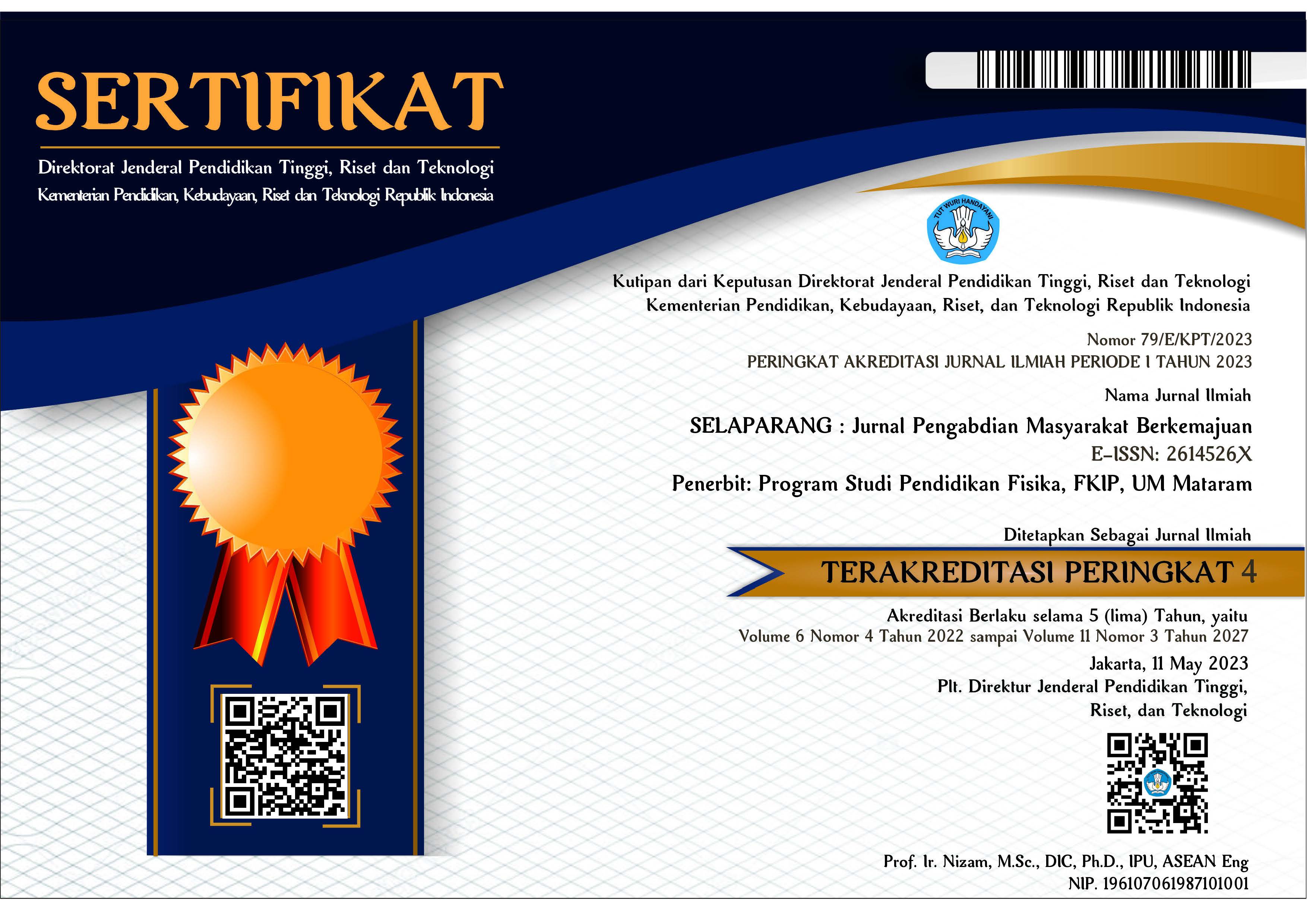Penyuluhan tentang sains cacing nyale pada guru-guru Sekolah Dasar di sekitar Kawasan Ekonomi Khusus Mandalika, Lombok Tengah
Abstract
Abstrak
Tradisi bau nyale merupakan peristiwa budaya terbesar di Provinsi Nusa Tenggara Barat. Setahun sekali, puluhan ribu masyarakat Lombok pergi menangkap nyale yang lokasinya di dalam Kawasan Ekonomi Khusus (KEK) Mandalika. Walaupun tradisi ini sudah berjalan ratusan tahun, sains tentang nyale dan cacing nyale tidak pernah diajarkan di sekolah. Pengajaran tentang nyale di dalam IPA di sekolah dasar hanya membahas tentang legenda Putri Mandalika, bahwa nyale merupakan penjelmaan dari putri yang cantik dan berbudi luhur. Survei terhadap guru IPA SMP dan guru Biologi SMA di Lombok menunjukkan bahwa para guru kekurangan informasi tentang sains atau biologi dari cacing nyale. Penyuluhan terhadap guru-guru SD diperlukan agar para guru dapat menyajikan sains tentang cacing nyale. Metode penyuluhan menggunakan sosialisasi, diskusi, dan demonstrasi. Peserta penyuluhan terdiri dari 22 guru SD di bawah Kelompok Kerja Guru Gugus 10, Kecamatan Pujut. Hasil-hasil penyuluhan menunjukkan bahwa guru-guru SD mengalami peningkatan pengetahuan yang sangat besar (antara 50-90%) dalam 6 (enam) aspek sains dari cacing nyale. Guru peserta penyuluhan juga berpendapat bahwa video pembelajaran dan komik yang dihasilkan oleh tim penelitian Universitas Mataram akan bermanfaat di dalam pengajaran IPA di sekolah mereka. Sebagian guru menyatakan keraguan untuk mengajarkan sains cacing nyale karena khawatir terlibat konflik dengan wali murid yang mempercayai legenda dan mitos Putri Nyale.
Kata kunci: sains; bau nyale; cacing; sekolah dasar; penyuluhan
Abstract
The “bau nyale” tradition is the largest cultural event in the province of West Nusa Tenggara. Tens of thousands of Lombok people annually go to harvest “nyale”, the epitokes of eunicid worms (Phyllum Polychaeta). Although this tradition has been going on for hundreds of years, the science of nyale and nyale worms has never been taught in schools. The teaching about nyale in elementary school science only discusses the legend of Princess Mandalika (Princess Nyale), that nyale is the embodiment of a beautiful and virtuous princess. Previous surveys on science and biology teachers in Lombok showed that the teachers lacked information about the science or biology of nyale worms. The present university outreach aims to improve knowledge of the elementary school teachers so that they can teach the science of nyale worms in their schools. The targeted outreach audiences were 22 Elementary School teachers in the Teacher Working Group X, Kecamatan Pujut. The results of the outreach showed that elementary school teachers experienced a very significant increase (between 50-90%) in knowledge of all six aspects on the science of nyale worms. The teachers participating in the outreach also believed that learning videos and comics, produced by the University of Mataram, will be beneficial in teaching science at their schools. Some teachers expressed hesitation in teaching the science of nyale worms because they were worried about getting into conflict with parents who believed in the legend and myth of Princess Nyale.
Keywords: science; harvest nyale; worms; elementary school; outreach
Keywords
Full Text:
PDFReferences
Ardhiati, Y., Begin, D. T., & Hariprasetyo, T. (2021). Mandalika: Eco-cultural Tourism in Lombok. The International Journal of Architectonic, Spatial, and Environmental Design, 16(2), 61. https://doi.org/10.18848/2325-1662/CGP/v16i02/61-73
Bachtiar, I. (2020). Printed-book reading habits of pre-service science-teacher students. TARBIYA: Journal of Education in Muslim Society, 7(2), 158–166. https://doi.org/10.15408/tjems.v7i2.16888
Bachtiar, I., & Bachtiar, N. T. (2019). Predicting spawning date of nyale worms (Eunicidae, Polychaeta) in the southern coast of Lombok Island, Indonesia. Biodiversitas Journal of Biological Diversity, 20(4), 971–977. https://doi.org/10.13057/biodiv/d200406
Bachtiar, I., Bahri, S., Handayani, B. S., & Marwatun, F. (2022a). Penggunaan Video Dan Modul Pembelajaran Dalam Penyuluhan Tentang Biologi Cacing Nyale Pada Siswa SMAN 1 Mataram. Jurnal Pendidikan Dan Pengabdian Masyarakat, 5(4), 399–405. https://doi.org/10.29303/jppm.v5i4.4280
Bachtiar, I., Handayani, B. S., Japa, L., & Bahri, S. (2022b). Learning Module Development on the Nyale Worm Biology for Highschool Students and Teachers. Jurnal Penelitian Pendidikan IPA, 8(2), 1000–1004. https://doi.org/10.29303/jppipa.v8i2.1322
Bachtiar, I., Japa, L., & Bahri, S. (2020a). Peningkatan Pengetahuan Guru Biologi SMA Negeri Tentang Biologi Cacing Nyale di Kabupaten Lombok Timur. Jurnal Pendidikan Dan Pengabdian Masyarakat, 3(4). https://doi.org/10.29303/jppm.v3i4.2295
Bachtiar, I., Japa, L., Bahri, S., & Handayani, B. S. (2020b). Modul Pembelajaran Biologi Cacing Nyale (1st ed.). Mataram University Press.
Bachtiar, I., Japa, L., Santoso, D., Bahri, S., & AR, S. (2019). Peningkatan pengetahuan guru IPA SMP/MTS tentang biologi cacing nyale di Kecamatan Pujut Kabupaten Lombok Tengah. Jurnal Pendidikan Dan Pengabdian Masyarakat, 2(4). https://doi.org/10.29303/jppm.v2i4.1496
Bachtiar, I., & Odani, S. (2021). Revisiting the Spawning Pattern of Nyale Worms (Eunicidae) Using the Metonic Cycle. Ilmu Kelautan: Indonesian Journal of Marine Sciences, 26(2). https://doi.org/10.14710/ik.ijms.26.2.87-94
Jekti, D. S. D., Purwoko, A. A., & Muttaqin, Z. (2008). Nyale sea worm as antibacterial substances. Jurnal Ilmu Dasar, 9(2), 120–126.
Jekti, D. S. D., Raksun, S., Julianti, E., Suryawati, H., Maswan, M., & Kastoro, W. (1993). Jenis-jenis Polychaeta di Pulau Lombok dan peristiwa Bau Nyale. Jurnal Ilmu-Ilmu Perairan Dan Perikanan Indonesia, 1(1), 21–32.
DOI: https://doi.org/10.31764/jpmb.v9i3.30773
Refbacks
- There are currently no refbacks.

This work is licensed under a Creative Commons Attribution-ShareAlike 4.0 International License.
______________________________________________________
Jurnal Selaparang
p-ISSN 2614-5251 || e-ISSN 2614-526X
EDITORIAL OFFICE:



















